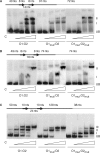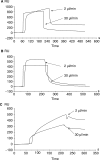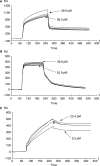Determination of the DNA-binding kinetics of three related but heteroimmune bacteriophage repressors using EMSA and SPR analysis
- PMID: 17412705
- PMCID: PMC1904268
- DOI: 10.1093/nar/gkm172
Determination of the DNA-binding kinetics of three related but heteroimmune bacteriophage repressors using EMSA and SPR analysis
Abstract
Bacteriophages P2, P2 Hy dis and WPhi are very similar but heteroimmune Escherichia coli phages. The structural genes show over 96% identity, but the repressors show between 43 and 63% identities. Furthermore, the operators, which contain two directly repeated sequences, vary in sequence, length, location relative to the promoter and spacing between the direct repeats. We have compared the in vivo effects of the wild type and mutated operators on gene expression with the complexes formed between the repressors and their wild type or mutated operators using electrophoretic mobility shift assay (EMSA), and real-time kinetics of the protein-DNA interactions using surface plasmon resonance (SPR) analysis. Using EMSA, the repressors formed different protein-DNA complexes, and only WPhi was significantly affected by point mutations. However, SPR analysis showed a reduced association rate constant and an increased dissociation rate constant for P2 and WPhi operator mutants. The association rate constants of P2 Hy dis was too fast to be determined. The P2 Hy dis dissociation response curves were shown to be triphasic, while both P2 and WPhi C were biphasic. Thus, the kinetics of complex formation and the nature of the complexes formed differ extensively between these very closely related phages.
Figures






Similar articles
-
A comparison of the DNA binding and bending capacities and the oligomeric states of the immunity repressors of heteroimmune coliphages P2 and WPhi.Nucleic Acids Res. 2007;35(10):3167-80. doi: 10.1093/nar/gkm171. Epub 2007 May 7. Nucleic Acids Res. 2007. PMID: 17485481 Free PMC article.
-
The transcriptional switch of bacteriophage WPhi, a P2-related but heteroimmune coliphage.J Virol. 1999 Dec;73(12):9816-26. doi: 10.1128/JVI.73.12.9816-9826.1999. J Virol. 1999. PMID: 10559293 Free PMC article.
-
Carboxyl-terminal domain dimer interface mutant 434 repressors have altered dimerization and DNA binding specificities.J Mol Biol. 1998 Nov 13;283(5):931-46. doi: 10.1006/jmbi.1998.2136. J Mol Biol. 1998. PMID: 9799634
-
A comparative analysis of the bifunctional Cox proteins of two heteroimmune P2-like phages with different host integration sites.Virology. 2009 Mar 15;385(2):303-12. doi: 10.1016/j.virol.2008.12.002. Epub 2009 Jan 15. Virology. 2009. PMID: 19150106
-
Mechanisms of genome propagation and helper exploitation by satellite phage P4.Microbiol Rev. 1993 Sep;57(3):683-702. doi: 10.1128/mr.57.3.683-702.1993. Microbiol Rev. 1993. PMID: 8246844 Free PMC article. Review.
Cited by
-
An improved method for surface immobilisation of RNA: application to small non-coding RNA-mRNA pairing.PLoS One. 2013 Nov 14;8(11):e79142. doi: 10.1371/journal.pone.0079142. eCollection 2013. PLoS One. 2013. PMID: 24244437 Free PMC article.
-
Stochastic analysis of the SOS response in Escherichia coli.PLoS One. 2009;4(5):e5363. doi: 10.1371/journal.pone.0005363. Epub 2009 May 8. PLoS One. 2009. PMID: 19424504 Free PMC article.
-
Electrophoretic Mobility Shift Assay for Identification of the Interaction Between a Viral Protein and DNA.Methods Mol Biol. 2025;2940:343-355. doi: 10.1007/978-1-0716-4615-1_30. Methods Mol Biol. 2025. PMID: 40515925
-
A comparison of the DNA binding and bending capacities and the oligomeric states of the immunity repressors of heteroimmune coliphages P2 and WPhi.Nucleic Acids Res. 2007;35(10):3167-80. doi: 10.1093/nar/gkm171. Epub 2007 May 7. Nucleic Acids Res. 2007. PMID: 17485481 Free PMC article.
-
Regulation mechanism of nitrite degradation in Lactobacillus plantarum WU14 mediated by Fnr.Arch Microbiol. 2024 Nov 4;206(12):455. doi: 10.1007/s00203-024-04183-1. Arch Microbiol. 2024. PMID: 39495382
References
-
- Nilsson AS, Haggård-Ljungquist E. In: The bacteriophages. 2nd edn. Calendar R, editor. Oxford: Oxford University Press; 2006. pp. 365–390.
-
- Renberg-Eriksson SK, Ahlgren-Berg A, DeGrooth J, Haggård-Ljungquist E. Characterization of the developmental switch region of bacteriophage P2 Hy dis. Virology. 2001;290:199–210. - PubMed
-
- Studier FW, Rosenberg AH, Dunn JJ, Dubendorff JW. Use of T7 RNA polymerase to direct expression of cloned genes. Methods Enzymol. 1990;185:60–89. - PubMed

